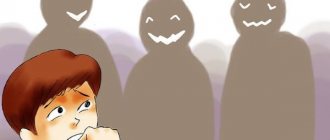In the modern world, stuttering is a common disease. Both adults and children suffer from it. In the former, this pathology has been delayed since childhood; later on, psychological disorders associated with the fear of communication may increase.
The disease can manifest itself in different ways and intensify or subside in a certain environment or with the emotional state of the patient.
In this article we will talk about the clinical types, forms and degrees of stuttering in preschool and school-age children, adolescents and adults, and characterize the types of logoneurosis.
Severity
How many degrees of stuttering are there? Diseases are divided according to their severity. Therefore, there are 3 degrees of stuttering in children and adults:
- Mild form of stuttering (logoneurosis). Practically does not interfere with free communication. The pathology practically does not manifest itself at all. But in a stressful situation or when trying to say something quickly, minor hesitations are possible.
But in a calm situation, speech becomes smooth and articulate again. If a mild degree of stuttering is detected in a child, then parents should pay attention, because it is better to treat the disease at an early stage.Otherwise it may progress. This earliest and mildest form of stuttering can cause many problems in the future.
- Average. Stuttering is severe in a child or adult only at the moment of emotional excitement. The patient cannot complete the sentence. In everyday communication, moderate stuttering practically does not interfere with a person’s communication, although it makes it difficult.
- Severe form of stuttering. Pathology manifests itself in any emotional state. The patient has difficulty communicating or avoids it in every possible way. High-grade stuttering is also accompanied by various kinds of complications: muscle spasms of the face, arms, legs, etc.
Adults suffer from stuttering from childhood. Precisely since then, when the pathology was not treated or simply ignored.
Usually a person begins to stutter when he is among a large number of people. It is accompanied by panic, a feeling of suffocation and a strong heartbeat. In adulthood, convulsions are recorded in all parts of the speech apparatus.
Speech is accompanied by unconscious and chaotic movements of the arms, legs and torso. A person usually tends to avoid communication. Very closed. Depression may develop on this basis.
Classification by flow type
It occurs as a result of the spread of excessive excitation of the motor centers of the brain to neighboring structures, including those centers that are responsible for emotions.
Spasms that occur in the speech apparatus (muscles of the palate, tongue, lips) or in the muscles of the larynx cause stuttering. It manifests itself when breathing is impaired, as respiratory spasms occur.
Pathology can occur in different types:
- Regredient. Improvement in symptoms, disappearance of signs of stuttering and fear of speech, seizures and associated pathologies are reduced.
- Chronic. If for some time (6 months) the signs of the disease do not go away, then stuttering is considered chronic. It occurs in the following ways:
- permanent. The signs and severity of the disease do not change over time. Associated symptoms: motor and psychopathic disorders also do not change. The disease progresses monotonously;
- recurrent. Recurrent stuttering is characterized by periods of remission, when clinical signs fade, and relapses: stuttering appears again;
- wavy. The patient’s speech is constantly changing: it either improves or worsens. Symptoms of wave-like stuttering can be seasonal, for example, worsening in the spring and summer, etc. Changes may depend on the age of the patient or some emotional reasons. But this type of disease also manifests itself in a person’s calm state, that is, for no apparent reason.
- Progressive. There is a gradual deterioration in the patient's condition.
A concomitant complication—embolophrasia—is also detected. This disorder is characterized by the fact that the patient constantly adds extra words in his speech (in short, so to speak, well, this, etc.) or repeats them; they do not make sense.
This is done in order to stall for time and choose words or structures that are more convenient for pronunciation.
Prevention measures
You should not fill your child’s life with an excessive number of entertainment activities. They negatively affect the nervous system, stimulating it. During the preschool period, the brain develops, so there is no need to overload the child.
When hesitating in speech, they provide maximum peace. You need to talk a little, remove all stress factors, reduce the number of sections, clubs, etc. Then contact a neurologist. The duration of the silence regime is determined by the doctor.
Characteristics according to etiology (causes of occurrence)
Pathology is also distinguished by the reason for its occurrence . Based on etiology, the following types of stuttering are distinguished: neurotic and neurosis-like.
Comparative characteristics of neurotic and neurosis-like forms of stuttering are presented in the table:
| Type of pathology | Causes | Symptoms |
| Neurotic | Adults and children get sick. The source of the disease is a negative psychological factor, fear or stress that a person experienced in childhood. But not all people become stutterers after experiencing negative experiences. It's all due to genetic predisposition. In such patients, there is increased convulsive readiness of the speech center and muscle and nervous tone. A child may begin to stutter under the influence of constant stress, for example, due to an unfavorable family environment. | In terms of severity it can be mild, moderate and severe. As it flows, it can be constant and independent of external circumstances, wave-like and recurrent. That is, periods of illness can intensify or weaken or even stop for a while and return again. Stuttering directly depends on a person’s emotional state. So, if he is among loved ones and in a calm environment, then clinical signs may be absent. Conversely, in society or in an unfamiliar environment, a stuttering clinic can show itself in all its glory and prevent the patient from interacting with society. |
| Neurosis-like | The source of the disease is organic brain damage and functional changes in the central nervous system. These lesions usually occur during fetal development. Birth trauma or infectious diseases influence the formation of pathology. Predisposing factors for the development of changes in the child’s brain include:
| The symptoms of the pathology are formed and manifested during the active formation of speech. Manifestations of the disease do not depend on the psycho-emotional state of the patient and are permanent. This type of stuttering is characterized by convulsions in the articulatory apparatus: the tongue, palate and lips. The patient's speech is monotonous and inexpressive. Children may experience general speech underdevelopment. Clinical signs of stuttering increase with increased speech load or after an infectious disease. During adolescence, the child’s symptoms may intensify. There is a fear of talking to strangers. Anxiety increases. The pathology is mainly wavy in nature. Depends on the psychological and physical state. |
Classification of stuttering
Experts use different classifications. The most popular is the one based on clinical signs. Understanding its features allows you to correctly structure your work and select methods of influence.
The neurotic form appears due to psychological factors - fear, stress. The introduction of a second foreign language, when parents use one or the other, confuses the child, he gets nervous, and gets confused in sounds.
In this form, the brain structures are not affected, there is no severe neurological history (asphyxia, hypoxia, trauma).
The violation is accompanied by:
- sleep problems;
- lack of appetite;
- anxiety;
- rapid change of mood.
The child speaks clearly for a long time, but with further stress, a stutter appears. With constant discomfort, the disease will become chronic.
The neurosis-like form appears against the background of severe trauma during pregnancy, childbirth, and the first year of life. The child has brain damage. Stuttering remains for life. The first problems appear at the age of three, gradually progressing.
According to the form of seizures and their manifestations
What other types of stuttering are there? Depending on their location, stuttering is divided into:
- Tonic. The most common type of pathology. Excessive excitement is transmitted to the speech apparatus, where a spasm occurs. As a result, normal speech is disrupted.
Usually the patient cannot pronounce any sound or start a new word. At the same time, the face and neck look very tense from the outside.There may also be prolonged contraction of the respiratory muscles and the patient often does not have enough air to continue speaking.
- Clonic. It is expressed in the repetition of individual sounds, parts of a word or the entire word. This type of pathology is characterized by involuntary and frequent contraction of the muscles of the speech apparatus. Typically, stuttering occurs before pronunciation with sounds that are difficult to pronounce.
- Mixed. The mixed form of stuttering can manifest as both clonic and clonic convulsions. One form can overlap another. The patient experiences long pauses or lapses in speech.
You can learn more about tonic and clonic stuttering in this article.
By localization
Convulsions that lead to hesitations in speech are localized in different areas:
- Articulatory. The spasm can affect the muscles of the face (contraction of the muscles of the upper or lower lip occurs, resulting in the pulling of the corners of the mouth to the sides or its convulsive opening, in some cases the muscles of the neck, forehead and ears also take part), the muscles of the tongue (its involuntary falling out of the cavity mouth, involuntary opening of the mouth, etc.), muscles of the soft palate (in this case, the passage from the pharynx to the nasal cavity either closes or opens).
- Respiratory. They are observed when inhaling, but they are hardly noticeable and appear as minor pauses in conversation. Occur with varying frequency and intensity. When exhaling, the patient has difficulty finishing a word or phrase. In this case, a strong contraction of the abdominal muscles occurs. The spasm affects the facial muscles, causing the face to become distorted. There is a feeling of lack of air.
- Voice. The vocal folds constantly close and open, causing the patient's speech to become intermittent and vibrating. During a conversation, the vocal folds can close completely, which leads to a sharp pause and loss of voice, while the person lacks air. A spasm occurs when pronouncing vowel sounds, and the patient lengthens them to such an extent that shortness of breath often occurs. The neck muscles tense and the voice becomes unnatural. Articulation may not be evident.
- Mixed. Convulsions during stuttering can alternate with each other and can overlap one another.
Stuttering
In this article we will discuss with DocDeti neurologist Olga Shemyatovskaya
stuttering problem. What do we mean by stuttering? This is a situation where speech fluency is impaired, speech is interrupted, characterized by atypical speed, rhythm and repetition of sounds, syllables, words and phrases.
Many people speak with impaired fluency: “uh”, “as if” or pronounce sounds/words several times - the difference is that if this happens infrequently, it does not cause discomfort in everyday communication. And for those who are familiar with stuttering, this problem is much more pronounced.
Young children are more likely than others to stutter - this is a common occurrence. Since their spoken language is not yet sufficiently developed, they simply do not have time to voice their thoughts. As they grow older, many cope with the problem of stuttering, outgrowing it.
But in some cases, stuttering does not go away, becoming chronic, which negatively affects self-esteem and communication with other people.
Most children begin to stutter between the ages of 2 and 6 years.
Risk factors:
1. Gender Boys are more likely to continue to stutter than girls.
2. Age when stuttering first appears. If a child began to stutter after 3.5 years, then most likely he will suffer from it longer.
3. Heredity. Have there been any cases of stuttering in the family?
Tension always accompanies stuttering, interfering with social interaction. For example, people avoid certain situations or words. Because of this, children may refuse to speak publicly, go on visits, or go for walks.
The degree of the problem can change in one direction or another every day: there are periods when you communicate freely, and there are times when your stuttering gets worse.
Sometimes obsessive movements (head nodding, blinking) are added to stuttering. Sometimes this is how people try to stop stuttering.
The degree of stuttering is influenced by feelings and attitudes: tension, disappointment, excitement or haste - lead to the fact that stuttering intensifies. Mimicking a person and drawing attention to his speech problem can also lead to this.
At what point should you see a doctor?
- The child stutters for more than 1 year
- The child began to stutter after 3.5 years
- Started avoiding communication or noted that it was difficult for him to have conversations
- There are cases of stuttering in the family.
What to do:
1. The correct reaction to the problem is necessary: do not fixate your attention, but also do not pretend that everything is in order.
2. Classes with a speech therapist will be useful.
3. If necessary (the child’s anxiety is increased), you should contact a child psychologist.
What NOT to do:
- Treat stuttering with dietary supplements, vitamins, and nootropics.










